Food Corporation Of India Mock Test- 2 - Government Jobs MCQ
30 Questions MCQ Test Food Corporation of India Mock Test Series 2024 - Food Corporation Of India Mock Test- 2
Read each sentence to find out whether there is any grammatical mistake/ error in it. Choose the sentence/option which is CORRECT (without any errors in it). If all the sentences are incorrect, mark Option 5 as the answer.
Read the sentence to find out whether there is any error in it or not. The error, if any, will be in one part of the sentence. The number of that part is the answer. If there is no error, the answer is (5). Ignore errors of punctuation, if any.
Q. The students (A)/ take a break (B)/ between 12:30 (C)/ to 1:30 PM. (D) No Error (E)
| 1 Crore+ students have signed up on EduRev. Have you? Download the App |
Read each sentence to find out whether there is any grammatical mistake/ error in it. Choose the sentence/option which is CORRECT (without any errors in it). If all the sentences are incorrect, mark Option 5 as the answer.
Read each sentence to find out whether there is any grammatical mistake/ error in it. Choose the sentence/option which is CORRECT (without any errors in it). If all the sentences are incorrect, mark Option 5 as the answer.
The following question consists of a sentence which is divided into four parts which contain grammatical errors in one or more than one part of the sentence. Mark the option which contains the error. If there is no error in any of the parts, mark 'No error' as your answer.
Q. Though mobocracy has no place (A)/ in our secular and democratic nation, (B)/ it is disturbing and painful (C)/ in a country like India. (D)/ No error (E)
The following question consists of a sentence which is divided into four parts which contain grammatical errors in one or more than one part of the sentence. Mark the option which contains the error. If there is no error in any of the parts, mark 'No error' as your answer.
Q. The task in balancing (A)/ the rights of innocent persons (B)/ facing false accusations (C)/ needs compassions and awareness. (D)/ No error (E)
The following question consists of a sentence which is divided into four parts which contain grammatical errors in one or more than one part of the sentence. Mark the option which contains the error. If there is no error in any of the parts, mark 'No error' as your answer.
Q. What happens when a court (A)/ determine that an atrocity case (B)/ is false and was filed (C)/ with mala fide intent? (D)/ No error (E)
The following question consists of a sentence which is divided into four parts which contain grammatical errors in one or more than one part of the sentence. Mark the option which contains the error. If there is no error in any of the parts, mark 'No error' as your answer.
Q. This could have enabled (A)/ the court as well as the government (B)/ to delves into the (C)/ relevant facts and datas. (D)/ No error (E)
The following question consists of a sentence which is divided into four parts which contain grammatical errors in one or more than one part of the sentence. Mark the option which contains the error. If there is no error in any of the parts, mark 'No error' as your answer.
Q. Over the past century, France (A)/ have received and successfully absorbed (B)/ millions of immigrant (C)/ from Europe and Asia. (D)/ No error (E)
The following question consists of a sentence which is divided into four parts which contain grammatical errors in one or more than one part of the sentence. Mark the option which contains the error. If there is no error in any of the parts, mark 'No error' as your answer.
Q. All of this meant that the (A)/ French did not have very (B)/ high expectations for their team (C)/ from this World Cup. (D)/ No error (E)
In the following question, the 3rd statement is fixed. Rearrange the remaining statements and answer the question which follows:
A. The tourism industry employs a large number of people both skilled and unskilled.
B. Tourism is the largest service industry in India with a contribution of 6.23 percent of the national GDP and 8,78 percent of the total employment in India.
C. The enchanting backwaters, hill stations and landscapes make India a beautiful country which attracts tourists from all over the world.
D. Our embassies should supply to the people and governments of other countries all the important information regarding objects and places which can attract the tourists
E. Tourism is one of the fastest growing industries of the world and it plays a vital role in the economic development of a country.
F. India is one of the popular tourist destinations in Asia and it offers a wide array of places to see and things to do.
Q. Which of the following should be the FIRST sentence after rearrangement?
In the following question, the 3rd statement is fixed. Rearrange the remaining statements and answer the question which follows:
A. The tourism industry employs a large number of people both skilled and unskilled.
B. Tourism is the largest service industry in India with a contribution of 6.23 percent of the national GDP and 8,78 percent of the total employment in India.
C. The enchanting backwaters, hill stations and landscapes make India a beautiful country which attracts tourists from all over the world.
D. Our embassies should supply to the people and governments of other countries all the important information regarding objects and places which can attract the tourists
E. Tourism is one of the fastest growing industries of the world and it plays a vital role in the economic development of a country.
F. India is one of the popular tourist destinations in Asia and it offers a wide array of places to see and things to do.
Q. Which of the following should be the SECOND sentence after rearrangement?
In the following question, the 3rd statement is fixed. Rearrange the remaining statements and answer the question which follows:
A. The tourism industry employs a large number of people both skilled and unskilled.
B. Tourism is the largest service industry in India with a contribution of 6.23 percent of the national GDP and 8,78 percent of the total employment in India.
C. The enchanting backwaters, hill stations and landscapes make India a beautiful country which attracts tourists from all over the world.
D. Our embassies should supply to the people and governments of other countries all the important information regarding objects and places which can attract the tourists
E. Tourism is one of the fastest growing industries of the world and it plays a vital role in the economic development of a country.
F. India is one of the popular tourist destinations in Asia and it offers a wide array of places to see and things to do.
Q. Which of the following should be the FOURTH sentence after rearrangement?
In the following question, the 3rd statement is fixed. Rearrange the remaining statements and answer the question which follows:
A. The tourism industry employs a large number of people both skilled and unskilled.
B. Tourism is the largest service industry in India with a contribution of 6.23 percent of the national GDP and 8,78 percent of the total employment in India.
C. The enchanting backwaters, hill stations and landscapes make India a beautiful country which attracts tourists from all over the world.
D. Our embassies should supply to the people and governments of other countries all the important information regarding objects and places which can attract the tourists
E. Tourism is one of the fastest growing industries of the world and it plays a vital role in the economic development of a country.
F. India is one of the popular tourist destinations in Asia and it offers a wide array of places to see and things to do.
Q. Which of the following should be the FIFTH sentence after rearrangement?
In the following question, the 3rd statement is fixed. Rearrange the remaining statements and answer the question which follows:
A. The tourism industry employs a large number of people both skilled and unskilled.
B. Tourism is the largest service industry in India with a contribution of 6.23 percent of the national GDP and 8,78 percent of the total employment in India.
C. The enchanting backwaters, hill stations and landscapes make India a beautiful country which attracts tourists from all over the world.
D. Our embassies should supply to the people and governments of other countries all the important information regarding objects and places which can attract the tourists
E. Tourism is one of the fastest growing industries of the world and it plays a vital role in the economic development of a country.
F. India is one of the popular tourist destinations in Asia and it offers a wide array of places to see and things to do.
Q. Which of the following should be the SIXTH sentence after rearrangement?
In the following question, two columns are given containing a connector and three phrases each. In the first column, the phrases are D, E and F. You have to make a meaningful sentence using the connectors in the starting and from the phrases of both the columns. There are five options, four of which display the sequence(s) in which the phrases with the connectors can be joined to form a grammatically and contextually correct sentence. If none of the options given forms a correct sentence after combination, select ‘none of these’ as your answer.
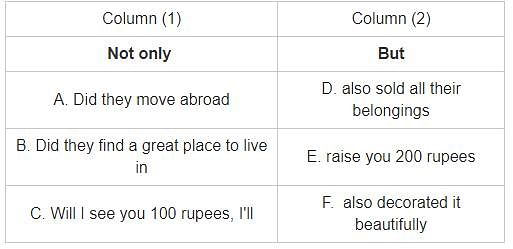
In the following question, two columns are given containing a connector and three phrases each. In the first column, the phrases are D, E and F. You have to make a meaningful sentence using the connectors in the starting and from the phrases of both the columns. There are five options, four of which display the sequence(s) in which the phrases with the connectors can be joined to form a grammatically and contextually correct sentence. If none of the options given forms a correct sentence after combination, select ‘none of these’ as your answer.
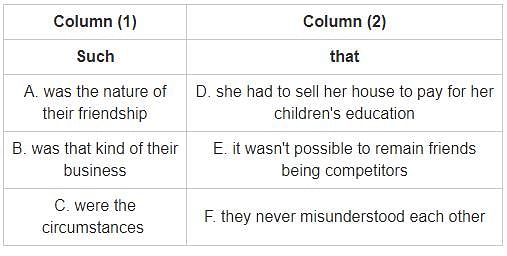
In the following question, two columns are given containing a connector and three phrases each. In the first column, the phrases are D, E and F. You have to make a meaningful sentence using the connectors in the starting and from the phrases of both the columns. There are five options, four of which display the sequence(s) in which the phrases with the connectors can be joined to form a grammatically and contextually correct sentence. If none of the options given forms a correct sentence after combination, select ‘none of these’ as your answer.
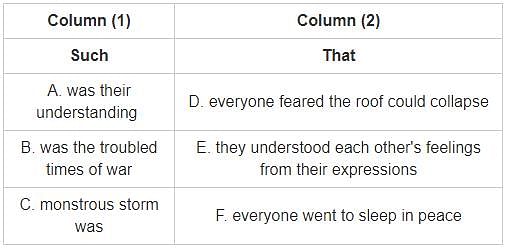
In the following question, two columns are given containing a connector and three phrases each. In the first column, the phrases are D, E and F. You have to make a meaningful sentence using the connectors in the starting and from the phrases of both the columns. There are five options, four of which display the sequence(s) in which the phrases with the connectors can be joined to form a grammatically and contextually correct sentence. If none of the options given forms a correct sentence after combination, select ‘none of these’ as your answer.
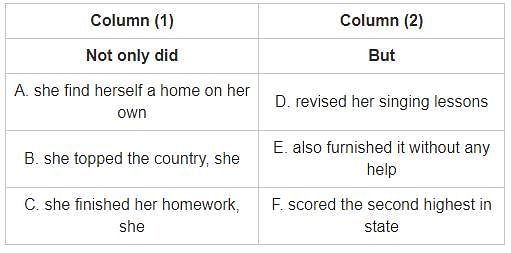
In the following question, two columns are given containing a connector and three phrases each. In the first column, the phrases are D, E and F. You have to make a meaningful sentence using the connectors in the starting and from the phrases of both the columns. There are five options, four of which display the sequence(s) in which the phrases with the connectors can be joined to form a grammatically and contextually correct sentence. If none of the options given forms a correct sentence after combination, select ‘none of these’ as your answer.
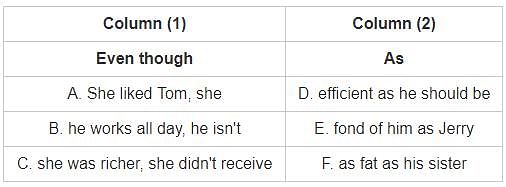
Fill in the blank using the appropriate options.
The old king called the three princesses to divide his kingdom equally _______ them.
A. Beyond
B. Because
C. Among
D. Between
E. Around
F. About
Fill in the blank using the appropriate options.
He had all the powers _______ to the minister at his disposal, yet he seemed unsure of his own position.
A. Been according
B. Have been accorded
C. Had accorded
D. Accord
E. Accorded
F. Accords
Fill in the blank using the appropriate options.
She remained standing, pointedly _______ his invitation to sit down at the table.
A. Disdainful
B. Disdaining
C. Disdained
D. Disdainfully
E. Had disdained
F. Being disdainful
Fill in the blank using the appropriate options.
The lady had been irritable all day because I _______ to inform her that he was coming.
A. Neglected
B. Have neglected
C. Had neglected
D. Had been neglected
E. Neglect
F. Neglecting
Fill in the blank using the appropriate options.
He was pleased to admit that all records of the past were zealously _______.
A. Had preserved
B. Preserved
C. Preserve
D. Preservatives
E. Preservation
F. Been preserved
Read the passage given below and then answer the questions given below the passage. Some words may be highlighted for your attention.
Migrating birds seem to have a ‘sixth sense’ in navigation infinitely superior to humans – so they can find their way to their nesting grounds. But exactly how they do this has long perplexed scientists. For a bird to know roughly where it is in the world – and correct itself if it goes off course – it needs what is known as ‘true navigation’. This means it can somehow work out its latitude and longitude.
The problem of longitude - the co-ordinate that specifies an east-west axis position on the Earth’s surface - proved unresolvable until the invention of accurate clocks. Now a study of a migratory bird, the Eurasian Reed Warblers –- has revealed the answer. The reed warblers, which spend summers in the UK, use a neat trick to navigate – by somehow measuring the variation between true north, and magnetic north. The little brown birds take advantage of a natural phenomenon called declination.
While a compass needle points to the magnetic north, this is not the true north – the North Pole. Depending on where you are, magnetic north is either one or more degrees further east or west of the north pole. By taking into account the difference between the magnetic north and true north, the reed warbler is able to sense how far west or east it is. The scientists have shown the reed warbler, can sense this difference – known as declination - and use the information to plot its longitudinal point on Earth. The way reed warblers do it remains a mystery, but the birds can use declination to work out their equivalent of longitude, the researchers found. In this way, they keep themselves pointing in the right direction during their autumnal migration from Russia to Africa.
Dr. Richard Holland, from the University of Bangor in Wales, said: ‘How birds have resolved the longitudinal problem has been a scientific mystery. It seems that a bird as unassuming as the reed warbler may have a geographic map or memory that enables it to identify its longitudinal position on the globe, only by detecting the magnetic north pole and its variance from true north. This, combined with other external cues, which may include the strength of the magnetic field, star positions, or smells, enables it to locate its current position and orient itself during a long migration.’
Dr. Holland’s team conducted tests on 15 adult Eurasian reed warblers about to start their migration from Rybachy, Russia. The caught birds were temporarily held in small funnel-shaped cages that could be used to record their orientation movements.
The findings of the work of Dr. Holland’s team are published in the journal Current Biology, which is also co-authored by Dr. Nikita Chernetsov.
Q. Which of the following statements can suitably be used at the end of the given passage?
Read the passage given below and then answer the questions given below the passage. Some words may be highlighted for your attention.
Migrating birds seem to have a ‘sixth sense’ in navigation infinitely superior to humans – so they can find their way to their nesting grounds. But exactly how they do this has long perplexedscientists. For a bird to know roughly where it is in the world – and correct itself if it goes off course – it needs what is known as ‘true navigation’. This means it can somehow work out its latitude and longitude.
The problem of longitude - the co-ordinate that specifies an east-west axis position on the Earth’s surface - proved unresolvable until the invention of accurate clocks. Now a study of a migratory bird, the Eurasian Reed Warblers –- has revealed the answer. The reed warblers, which spend summers in the UK, use a neat trick to navigate – by somehow measuring the variation between true north, and magnetic north. The little brown birds take advantage of a natural phenomenon called declination.
While a compass needle points to the magnetic north, this is not the true north – the North Pole. Depending on where you are, magnetic north is either one or more degrees further east or west of the north pole. By taking into account the difference between the magnetic north and true north, the reed warbler is able to sense how far west or east it is. The scientists have shown the reed warbler, can sense this difference – known as declination - and use the information to plot its longitudinal point on Earth. The way reed warblers do it remains a mystery, but the birds can use declination to work out their equivalent of longitude, the researchers found. In this way, they keep themselves pointing in the right direction during their autumnal migration from Russia to Africa.
Dr. Richard Holland, from the University of Bangor in Wales, said: ‘How birds have resolved the longitudinal problem has been a scientific mystery. It seems that a bird as unassuming as the reed warbler may have a geographic map or memory that enables it to identify its longitudinal position on the globe, only by detecting the magnetic north pole and its variance from true north. This, combined with other external cues, which may include the strength of the magnetic field, star positions, or smells, enables it to locate its current position and orient itself during a long migration.’
Dr. Holland’s team conducted tests on 15 adult Eurasian reed warblers about to start their migration from Rybachy, Russia. The caught birds were temporarily held in small funnel-shaped cages that could be used to record their orientation movements.
The findings of the work of Dr. Holland’s team are published in the journal Current Biology, which is also co-authored by Dr. Nikita Chernetsov.
Q. The declination referred to in the passage is a phenomenon which _____________.
Read the passage given below and then answer the questions given below the passage. Some words may be highlighted for your attention.
Migrating birds seem to have a ‘sixth sense’ in navigation infinitely superior to humans – so they can find their way to their nesting grounds. But exactly how they do this has long perplexedscientists. For a bird to know roughly where it is in the world – and correct itself if it goes off course – it needs what is known as ‘true navigation’. This means it can somehow work out its latitude and longitude.
The problem of longitude - the co-ordinate that specifies an east-west axis position on the Earth’s surface - proved unresolvable until the invention of accurate clocks. Now a study of a migratory bird, the Eurasian Reed Warblers –- has revealed the answer. The reed warblers, which spend summers in the UK, use a neat trick to navigate – by somehow measuring the variation between true north, and magnetic north. The little brown birds take advantage of a natural phenomenon called declination.
While a compass needle points to the magnetic north, this is not the true north – the North Pole. Depending on where you are, magnetic north is either one or more degrees further east or west of the north pole. By taking into account the difference between the magnetic north and true north, the reed warbler is able to sense how far west or east it is. The scientists have shown the reed warbler, can sense this difference – known as declination - and use the information to plot its longitudinal point on Earth. The way reed warblers do it remains a mystery, but the birds can use declination to work out their equivalent of longitude, the researchers found. In this way, they keep themselves pointing in the right direction during their autumnal migration from Russia to Africa.
Dr. Richard Holland, from the University of Bangor in Wales, said: ‘How birds have resolved the longitudinal problem has been a scientific mystery. It seems that a bird as unassuming as the reed warbler may have a geographic map or memory that enables it to identify its longitudinal position on the globe, only by detecting the magnetic north pole and its variance from true north. This, combined with other external cues, which may include the strength of the magnetic field, star positions, or smells, enables it to locate its current position and orient itself during a long migration.’
Dr. Holland’s team conducted tests on 15 adult Eurasian reed warblers about to start their migration from Rybachy, Russia. The caught birds were temporarily held in small funnel-shaped cages that could be used to record their orientation movements.
The findings of the work of Dr. Holland’s team are published in the journal Current Biology, which is also co-authored by Dr. Nikita Chernetsov.
Q. What is the most apt title for the given passage?
Read the passage given below and then answer the questions given below the passage. Some words may be highlighted for your attention.
Migrating birds seem to have a ‘sixth sense’ in navigation infinitely superior to humans – so they can find their way to their nesting grounds. But exactly how they do this has long perplexed scientists. For a bird to know roughly where it is in the world – and correct itself if it goes off course – it needs what is known as ‘true navigation’. This means it can somehow work out its latitude and longitude.
The problem of longitude - the co-ordinate that specifies an east-west axis position on the Earth’s surface - proved unresolvable until the invention of accurate clocks. Now a study of a migratory bird, the Eurasian Reed Warblers –- has revealed the answer. The reed warblers, which spend summers in the UK, use a neat trick to navigate – by somehow measuring the variation between true north, and magnetic north. The little brown birds take advantage of a natural phenomenon called declination.
While a compass needle points to the magnetic north, this is not the true north – the North Pole. Depending on where you are, magnetic north is either one or more degrees further east or west of the north pole. By taking into account the difference between the magnetic north and true north, the reed warbler is able to sense how far west or east it is. The scientists have shown the reed warbler, can sense this difference – known as declination - and use the information to plot its longitudinal point on Earth. The way reed warblers do it remains a mystery, but the birds can use declination to work out their equivalent of longitude, the researchers found. In this way, they keep themselves pointing in the right direction during their autumnal migration from Russia to Africa.
Dr. Richard Holland, from the University of Bangor in Wales, said: ‘How birds have resolved the longitudinal problem has been a scientific mystery. It seems that a bird as unassuming as the reed warbler may have a geographic map or memory that enables it to identify its longitudinal position on the globe, only by detecting the magnetic north pole and its variance from true north. This, combined with other external cues, which may include the strength of the magnetic field, star positions, or smells, enables it to locate its current position and orient itself during a long migration.’
Dr. Holland’s team conducted tests on 15 adult Eurasian reed warblers about to start their migration from Rybachy, Russia. The caught birds were temporarily held in small funnel-shaped cages that could be used to record their orientation movements.
The findings of the work of Dr. Holland’s team are published in the journal Current Biology, which is also co-authored by Dr. Nikita Chernetsov.
Q. According to Dr. Holland, what factors help the birds find their current position and orient themselves during their long journeys?
- star positions
- sense of smell
- strength of the magnetic field
Read the passage given below and then answer the questions given below the passage. Some words may be highlighted for your attention.
Migrating birds seem to have a ‘sixth sense’ in navigation infinitely superior to humans – so they can find their way to their nesting grounds. But exactly how they do this has long perplexed scientists. For a bird to know roughly where it is in the world – and correct itself if it goes off course – it needs what is known as ‘true navigation’. This means it can somehow work out its latitude and longitude.
The problem of longitude - the co-ordinate that specifies an east-west axis position on the Earth’s surface - proved unresolvable until the invention of accurate clocks. Now a study of a migratory bird, the Eurasian Reed Warblers –- has revealed the answer. The reed warblers, which spend summers in the UK, use a neat trick to navigate – by somehow measuring the variation between true north, and magnetic north. The little brown birds take advantage of a natural phenomenon called declination.
While a compass needle points to the magnetic north, this is not the true north – the North Pole. Depending on where you are, magnetic north is either one or more degrees further east or west of the north pole. By taking into account the difference between the magnetic north and true north, the reed warbler is able to sense how far west or east it is. The scientists have shown the reed warbler, can sense this difference – known as declination - and use the information to plot its longitudinal point on Earth. The way reed warblers do it remains a mystery, but the birds can use declination to work out their equivalent of longitude, the researchers found. In this way, they keep themselves pointing in the right direction during their autumnal migration from Russia to Africa.
Dr. Richard Holland, from the University of Bangor in Wales, said: ‘How birds have resolved the longitudinal problem has been a scientific mystery. It seems that a bird as unassuming as the reed warbler may have a geographic map or memory that enables it to identify its longitudinal position on the globe, only by detecting the magnetic north pole and its variance from true north. This, combined with other external cues, which may include the strength of the magnetic field, star positions, or smells, enables it to locate its current position and orient itself during a long migration.’
Dr. Holland’s team conducted tests on 15 adult Eurasian reed warblers about to start their migration from Rybachy, Russia. The caught birds were temporarily held in small funnel-shaped cages that could be used to record their orientation movements.
The findings of the work of Dr. Holland’s team are published in the journal Current Biology, which is also co-authored by Dr. Nikita Chernetsov.
Q. Which of the following is closer in meaning to the word perplexed as used in the passage?

















